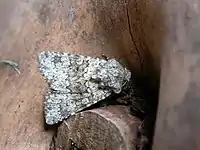Hecatera dysodea
Hecatera dysodea, the small ranunculus, is a moth of the family Noctuidae. It is found in Europe, primarily in Central Europe and Southern Europe The northern boundary of the distribution is from the Baltic Sea and the southern part of Lithuania, Belarus, south of Moscow to the Urals. North Africa forms the distribution border in the south (from Algeria and Morocco) east they extend to the Middle East, Turkestan and across the Palearctic to Central Asia. It is an introduced species in North America, where it was first found in Utah in 1998 and Oregon in 2005.

.JPG.webp)
| Hecatera dysodea | |
|---|---|
 | |
| Scientific classification | |
| Domain: | Eukaryota |
| Kingdom: | Animalia |
| Phylum: | Arthropoda |
| Class: | Insecta |
| Order: | Lepidoptera |
| Superfamily: | Noctuoidea |
| Family: | Noctuidae |
| Genus: | Hecatera |
| Species: | H. dysodea |
| Binomial name | |
| Hecatera dysodea (Denis & Schiffermüller, 1775) | |
| Synonyms | |
| |
The wingspan is 32–34 mm. The length of the forewings is 14–15 mm. Meyrick describes it thus - Forewings whitish irrorated with grey, median area suffused with grey and partly mixed with orange; subbasal line whitish, edged anteriorly with black mixed with orange; first and second lines whitish, edged internally with blackish; spots outlined with black mixed with orange; subterminal line formed of orange spots, preceded by some black scales. Hindwings pale grey, with darker posterior suffusion. Larva pale dull green, or yellowish freckled with brown; dorsal line pale, dark-edged; lateral dark, indistinct; spiracles black; head ochreous-brown or dull greenish.[1]
The moths are found mainly on the edge or in localities. They prefer dry ruderal areas, brownfields, roadsides, embankments, gardens and parks. In the Alps they rise up to 1400 m. They fly in one generation from May to mid August. . Their cocoons typically hatch during the month of June when the humidity levels increase
The larvae feed on flowers and seeds of Asteraceae species, especially Lactuca species.
Subspecies
There are two recognised subspecies:
- Hecatera dysodea dysodea
- Hecatera dysodea nebulosa
References
- Meyrick, E., 1895 A Handbook of British Lepidoptera MacMillan, London pdf
 This article incorporates text from this source, which is in the public domain.
This article incorporates text from this source, which is in the public domain.
Notes
- ^ The flight season refers to Belgium and The Netherlands. This may vary in other parts of the range.
External links
 Media related to Hecatera dysodea at Wikimedia Commons
Media related to Hecatera dysodea at Wikimedia Commons- Small Ranunculus at UKmoths
- Lepiforum.de
- Vlindernet.nl (in Dutch)